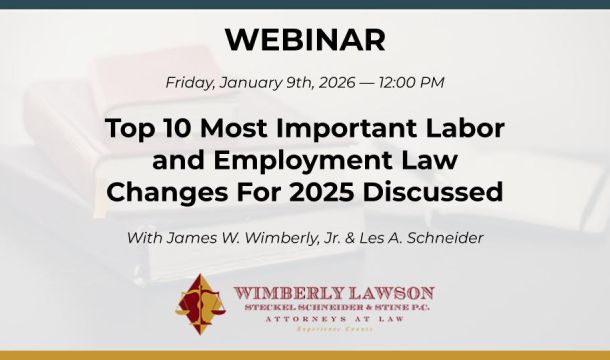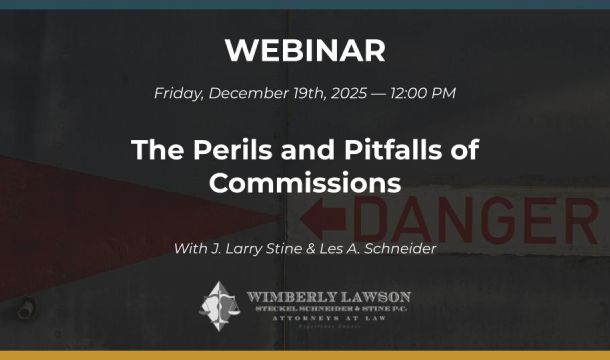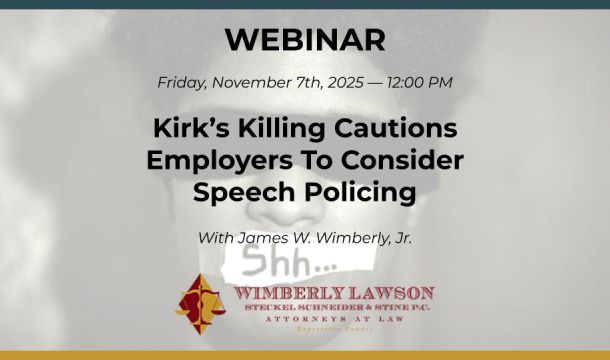Supreme Court Gives Donning and Doffing Guidance
On January 27, 2014, the U.S. Supreme Court rendered an important donning and doffing ruling in Sandifer v. United States Steel Corp. (No. 12-417). The case concerned issues of whether donning and doffing certain protective gear was compensable. The Court ruled that the time spent donning and doffing protective gear was not compensable because of Section 203(o), a special provision of the wage-hour law applicable only to operations covered by a labor agreement. The case and more significantly its ramifications are highly important to both union and non-union employers.
The facts involved a steel-making facility in which employees were required to don and doff the following types of required protective gear: a flame-retardant jacket, pair of pants, and hood; a hard hat; a "snood"; "wristlets"; work gloves; leggings; "metatarsal" boots; safety glasses; ear plugs; and a respirator. The plaintiffs sued contending that they wanted to be paid for the time they spent putting on and taking off these objects.
For purposes of this decision, the Court stated the case turned on the application of Section 203(o), which in pertinent part states: ". . . there shall be excluded any time spent in changing clothes or washing at the beginning or end of each work day which was excluded from measured working time during the week involved by the express terms of or by custom or practice under a bona fide collective-bargaining agreement applicable to the particular employee."
The Court describes this portion of the statute as providing that the compensability of time spent changing clothes or washing is a subject appropriately committed to collective bargaining. Later, the Court reiterates that the object of Section 203(o) is to permit collective bargaining over the compensability of clothes-changing time and to promote the predictability achieved through mutually beneficial negotiations.
The plaintiff argued that the word "clothes" was indeterminate and should not include items designed and used to protect against workplace hazards. Plaintiff further argued that even if "clothes" included the protective gear at issue, the exception did not apply unless there was a "changing" of clothes, which meant to substitute one item of changing for another, rather than simply adding protective gear.
As to the first contention, the Court rejected the proposition that "clothes" somehow excluded protective clothing. The distinction offered by Plaintiffs would reduce 3(o) to “near nothingness.” It is only when employees change into protective clothing that the issue arises as to whether the activity becomes "an integral and indispensable part of the principal activities for which covered workmen are employed.” Thus, section 3(o) is meant to exclude that time.
The Court did find some limitation to the word "clothes" as the term is not so broad to mean essentially anything worn on the body – including accessories, tools, and so forth. The Court indicated its definition leaves room for distinguishing between clothes and wearing items that are not clothes, such as some equipment and devices. The Court refused to find that "clothes" excluded all objects that could conceivably be characterized as equipment.
Addressing the second argument of plaintiffs dealing with "changing clothes," the Court ruled that the term "changing" included not only to "substitute" but also to "alter." The Court thus found that "time spent in changing clothes" included time spent in altering dress.
Applying the principles to the facts of the case, the Court found that the first nine particular items donned and doffed clearly fit within the interpretation of clothes, as they were both designed and used to cover the body and are commonly regarded as articles of dress. However, three items did not meet the definition, glasses, earplugs, and respirators. The question then was whether the time devoted to the putting on and taking off these three items must be deducted from the non-compensable time.
In one of the two most controversial portions of the ruling, the Court stated that: "We doubt that the de mininis doctrine can properly apply to the present case." The Court stated that ". . . we nonetheless agree with the basic perception of the Courts of Appeals that it is most unlikely Congress meant Section 203(o) to convert federal judges into time-study professionals." The Court analogized that just as one can speak of "spending a day skiing" even when less-than-negligible portions of the day are spent having lunch or drinking hot toddies, so one can speak of "time spent changing clothes and washing" when the vast preponderance in question is devoted to those activities. The question for the Court is whether the period at issue can, on the whole, be fairly characterized as "time spent in changing clothes or washing." ". . . if the vast majority of the time is spent in donning and doffing 'clothes' as we have defined that term, the entire period qualifies, and the time spent putting on and off other items need not be subtracted."
Thus, under the facts of the case, all the time spent donning and doffing the twelve items of protective clothing were deemed non-compensable because of the Section 203(o) exemption for collective bargaining relationships.
Wimberly & Lawson Comments:
The following comments are going to be controversial, as different attorneys may draw different interpretations from the Sandifer ruling. Therefore, please remember that the following comments are not "black letter law," but instead one law firm's interpretation of the ruling and its ramifications to union and non-union employers.
The first controversial point has already been mentioned, basically whether the Sandifer case abolishes the de minimis rule under the wage-hour laws. The de minimis doctrine, as noted in the Sandifer case, is a long-standing doctrine that has been previously acknowledged as good law by the U.S. Supreme Court, and it currently exists as a standard under federal wage-hour regulations in 29 C.F.R. Section 785.47. Our firm places great significance on the fact that the context of the Court's ruling was limited to the application of Section 203(o), and not to the entire wage-hour law. We believe that the Court is saying that the de minimis doctrine does not apply to Section 203(o); it is not saying that the de minimis rule does not apply anywhere under the wage-hour laws.
The Court nowhere indicated that the de minimis doctrine as outlined in an earlier Supreme Court ruling in Anderson v. Mt. Clemens Pottery Co., 328 U.S. 680 (1946), was no longer applicable under the wage-hour laws, or that the federal wage-hour regulations applying the de minimis concept were no longer valid. Thus, we believe there is room for the continuing application of the de minimis doctrine under wage-hour law, although courts may feel more inclined in light of Sandifer to make more limited applications of the doctrine. Further, plaintiffs are sure to argue that the doctrine no longer exists under the wage-hour laws.
Another point worth mentioning here is that the Court actually applies a more favorable (to employers) doctrine than the de minimis rule in the context of Section 203(o). That is, the Court talks about not making federal judges into "time-study experts" and determining whether the vast majority of the time was spent in changing clothes, or changing certain types of equipment not considered clothes. The Court, in essence, is applying something akin to the "vast majority" of time spent in non-compensable activities, versus compensable activities, and indicating the entire time is to be counted as non-compensable under those circumstances. This conceptually is a more valuable doctrine than de minimis, although again the Court is only talking about Section 203(o).
In light of the Court's explanation of the concept to Section 203(o), one wonders whether the same concept would be applied by the Court to lunch periods. Some courts have indicated that if lunch periods of 30 minutes or longer are primarily for the benefit of the employee to have lunch, the fact that some compensable donning and doffing is performed during that lunch period does not destroy the non-compensability of the entire lunch period. The Court's rationale in Sandifer seems to support this concept concerning lunch periods, although it would be reasoning by analogy. This conclusion further supported by the favorable citation to Sepulveda v. Allen Family Foods, Inc., 591 F.3d.209, 218 which applied this reasoning to meal breaks.
Perhaps the most controversial part of the Sandifer ruling is, however, how it affects the non-union sector. There is a simple sentence in the ruling referring to donning and doffing the twelve items of required protective gear that "because this donning-and-doffing time would otherwise be compensable under the Act." Some commentators and all plaintiffs' lawyers will take the position that this means the donning and doffing of protective gear should never be from compensable time as preliminary or postliminary to the principal activity or activities that an employee is employed to perform under the Portal-to-Portal Act. That Act excludes from compensable time such activities. If this interpretation of Sandifer is correct, then a powerful defense would be unavailable to employers, that the donning and doffing of protective equipment in some circumstances at least should be excluded from compensation as preliminary or postliminary time. When combined with the plaintiff's argument that the de minimis rule no longer applies, non-union employers would have few defenses left to defend donning and doffing lawsuits.
Wimberly & Lawson believes that the Supreme Court did not go that far. Indeed, the Court cited Steiner v. Mitchell for the proposition that "changing clothes and showering" can, under some circumstances, be considered an "integral and indispensable part of the principal activities for which covered workmen are employed. . . ." The Court also discussed its IBT ruling as applying Steiner to treat as compensable the donning and doffing of protective gear somewhat similar to that at issue here, meaning the twelve items of protective clothing involved in the Sandifer fact pattern. In its decision, the Court indicates that it is talking about "items that can be regarded as integral to job performance." Later, the Court expressly limits its holding to the "donning and doffing of the protective gear at issue," referring to the twelve particular items which included a flame-retardant jacket, pair of pants, hood, hard hat, snood, wristlets, work gloves, leggings, metatarsal boots, safety glasses, ear plugs and a respirator.
The significance of this point is that many cases draw a distinction between "unique" and "non-unique" protective gear, indicating that "heavy" or "unique" protective gear is not subject to the preliminary and postliminary exception of compensable work time under the Portal-to-Portal Act. Thus, a close reading of the Sandifer case indicates there is still room to argue this distinction, in addition to the de minimis doctrine. Indeed, we believe the case could open up a new argument for employers that the Court looks to see which activity constitutes the vast majority of time – donning and doffing gear that is an integral and indispensable part of the principal activity or donning and doffing gear that is not integral and indispensable.
Nevertheless, there is no question that as a result of the Sandifer decision, more donning and doffing lawsuits will be brought in the non-union sector. In contrast, in the union sector, there will likely be fewer such suits. Non-union employers need to look at their work practices and determine how, if any, they should be modified because of the additional legal exposure.
For questions or additional information call James W. Wimberly, Jr., J. Larry Stine, Elizabeth Dorminey, or any other attorney at (404) 365-0900 or at jww@wimlaw.com, jls@wimlaw.com, or ekd@wimlaw.com.
Related Content
Get Email Updates
Recent Content

Department of Homeland Security (DHS) is Terminating Family Reunification Parole (FRP) Processes

DHS is Terminating Temporary Protected Status for Ethiopia

Issues Regarding Employee Access to Their Personnel Files

Issues of Employer Access to Employees’ Personal Devices Such as Cell Phones, Etc

Settlement Agreement Wording Can Determine Tax Treatment



